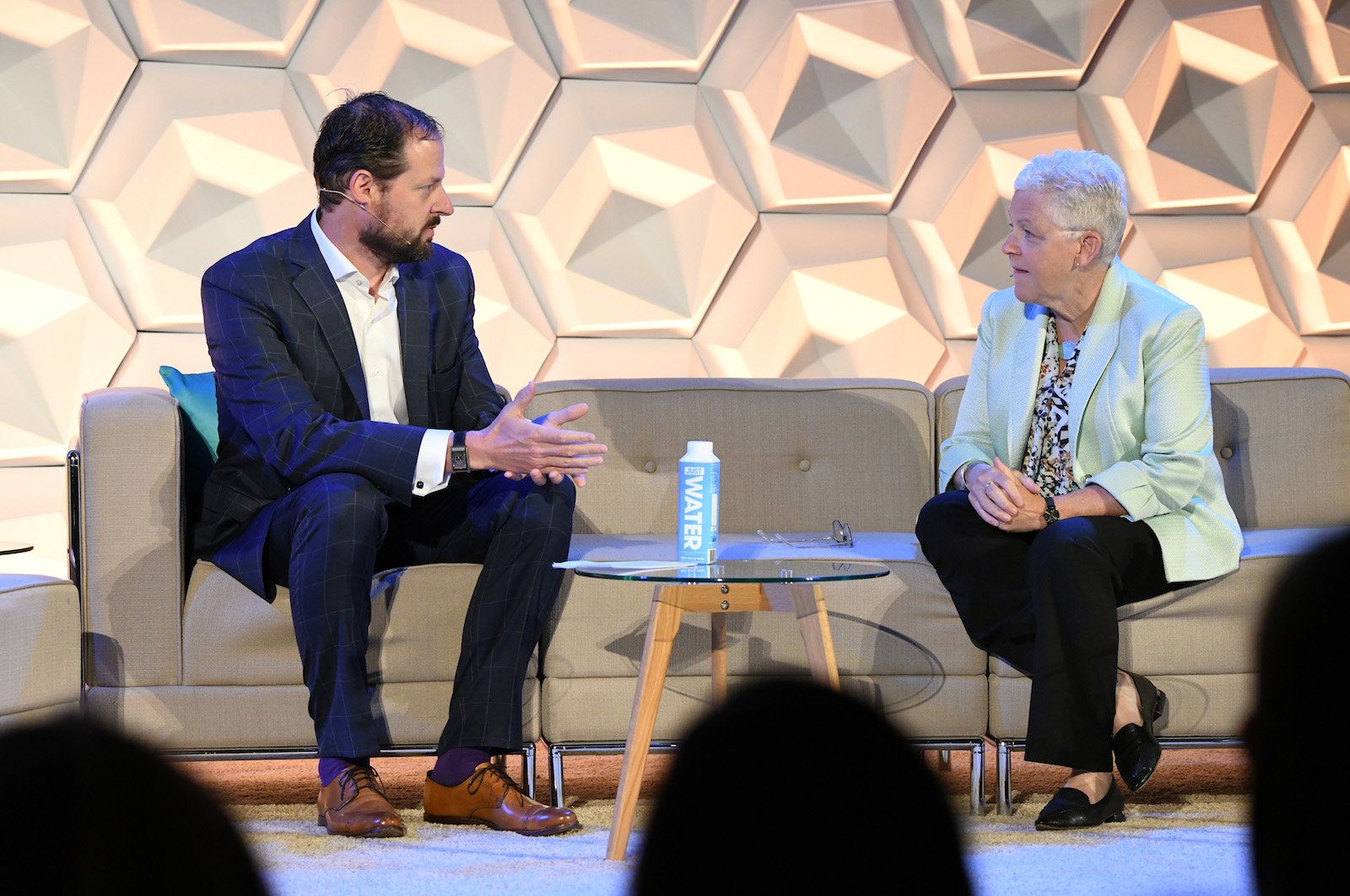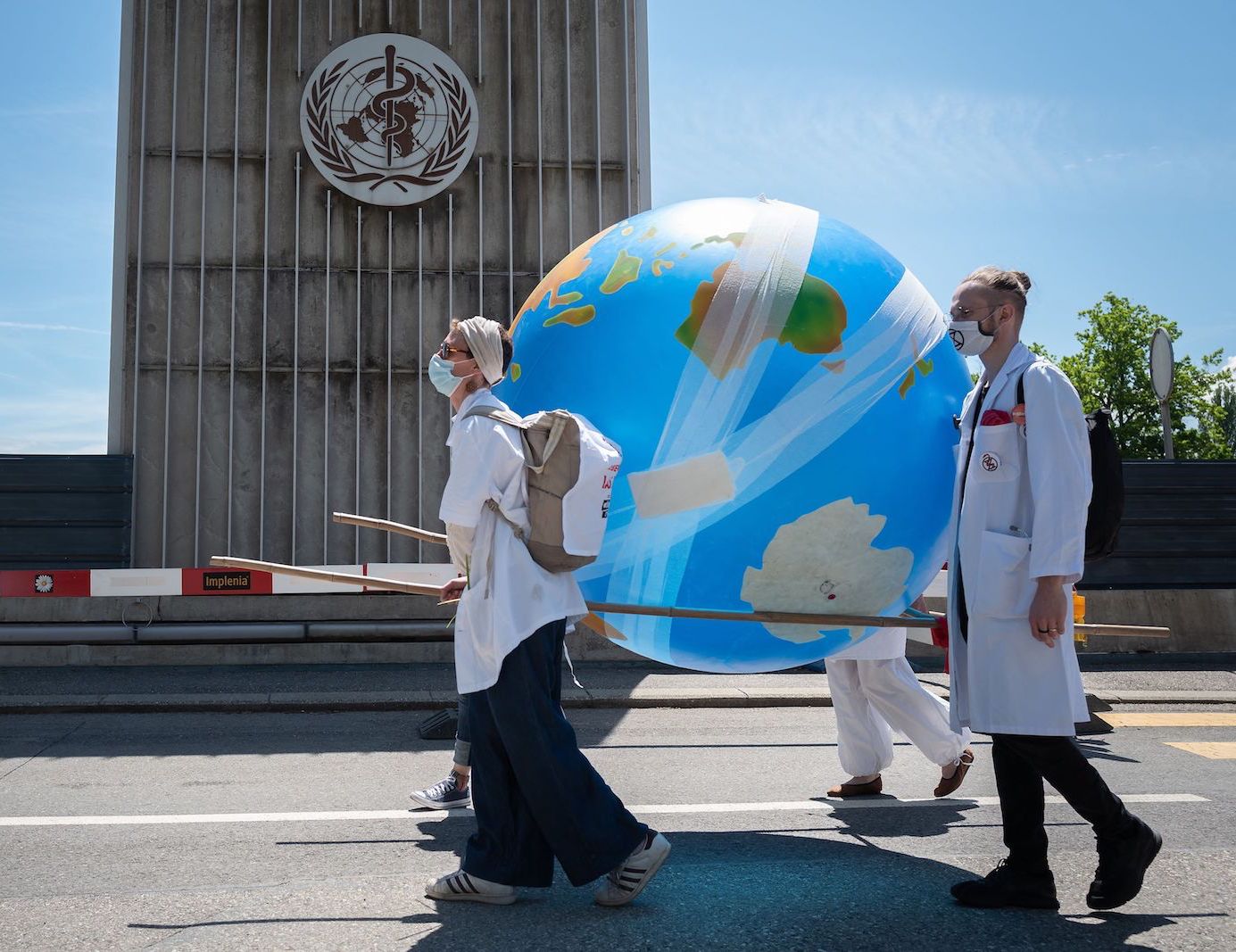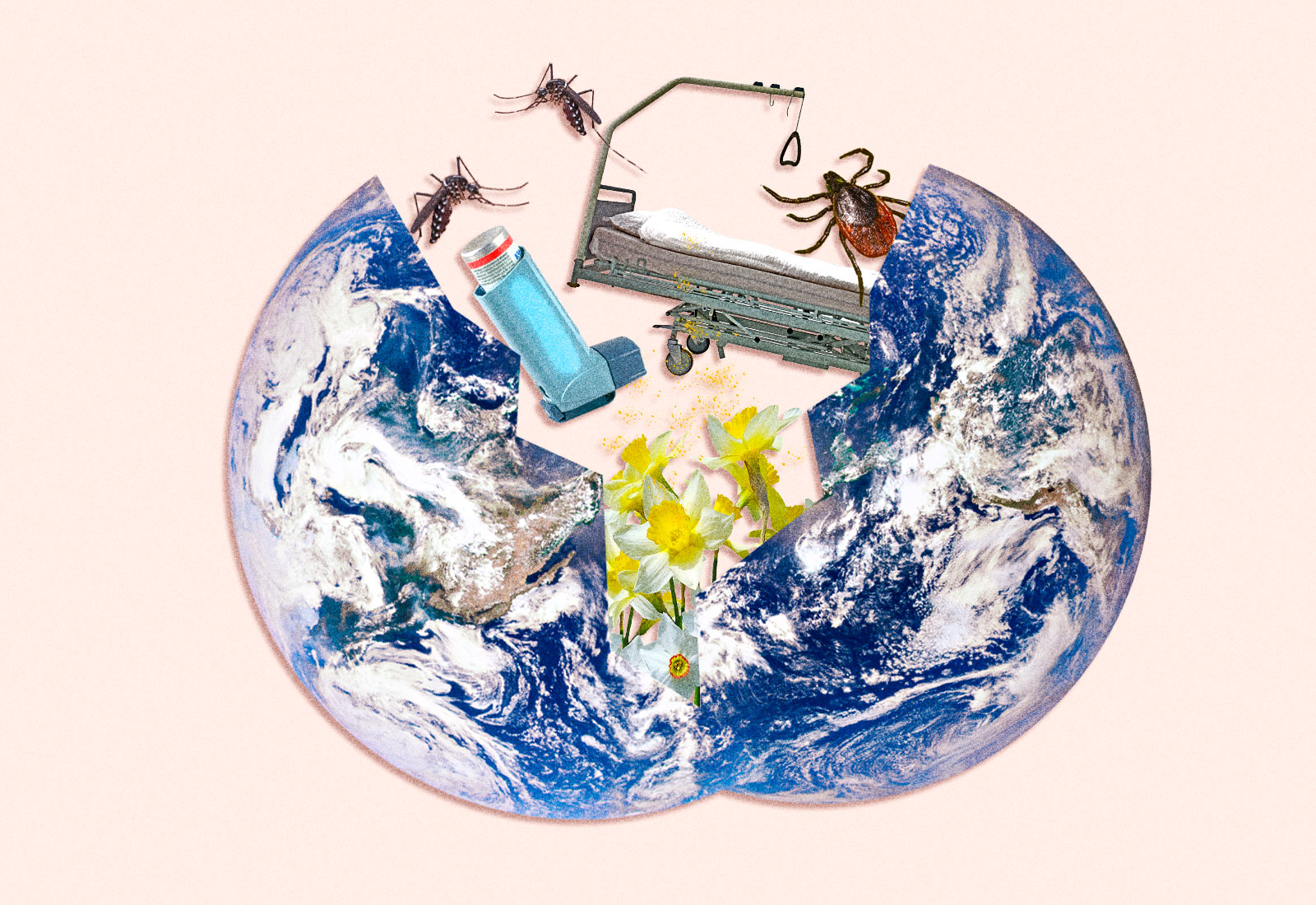It’s easy to think about the global climate crisis in the abstract. Ella Adoo-Kissi-Debrah’s death gave it a face. The 9-year-old girl’s fatal asthma attack might have passed without public notice except for the fact that, after a long legal fight, it became the first British death officially attributed to fossil fuel-caused air pollution. When she died in 2013, no doctors mentioned environmental causes. Had her mother known that their southeast London neighborhood’s air was so toxic — and could worsen with dramatic temperature change — she said she would have moved the family somewhere safer.
The question remains: Did the medical profession have a responsibility to tell her?
Preventing this kind of tragedy, most doctors and medical associations now agree, starts with better training. In the U.S., where recent research has found that one in ten premature deaths are caused by air-polluting fossil fuels, medical schools have only begun grappling with a lack of curricula focused on climate change in the last couple of years. Now, a small group of physicians are arguing that only a broader reckoning can help their profession meet the challenge posed by climate change.
“In the mind of the public, health and climate change represent different and separate realms of knowledge and concern,” laments the latest annual report on health and climate change published by the leading medical journal The Lancet earlier this year. The report, which has become the most globally respected pulse-taking of human health in a changing climate since its first publication after the 2016 Paris Agreement, shows just how high the stakes are.
The paper says that climate change is already affecting human health in every country on earth. It’s worsening the spread of infectious diseases, like dengue across South America, increasing the possibility of global pandemics in the near future. Continued reliance on fossil fuels is causing 7 million additional deaths worldwide from air pollution, and extreme heat is killing more people than ever before.

In 2018, about 280,000 people died from extreme heat worldwide, a nearly 55 percent increase from 20 years ago. Europe’s aging population remains the most vulnerable to heat exposure overall, as the continent endures heatwaves made 10 percent worse by climate change. Conditions in China and India, which lost 62,000 and 31,000 people to heat in 2018, respectively, are raising new red flags. The past five years have been the hottest on record for the planet, with 2020 being an especially hot and deadly year in the American Southwest, according to reporting by NPR. Arizona alone reported 494 heat-related deaths, its worst annual toll ever.
Americans are already showing up in emergency rooms with more surprising climate-related ailments, too — like diarrhea.
In New Jersey, over 47,000 people were hospitalized for gastrointestinal illness between 2009 and 2013. That didn’t raise eyebrows until years later, when state researchers looked at these numbers next to weather data. They found a strong link between where these patients lived, how they sourced their water, and really heavy rains. The 2017 study concluded that New Jersey’s surface water systems, like reservoirs, were being contaminated by worsening deluges. The growing belief is that the state’s old water systems weren’t built for new extreme rain — and that this is what gave New Jersey residents, and kids under five especially, the kind of diarrhea that lands someone in the ER.
Detecting the fingerprints of climate change on local weather events is tricky, but dire climate predictions are motivating similar drinking water studies in other states that are getting wetter. In Massachusetts, ERs saw a spike of severe diarrhea cases after extreme rain fell in towns with especially vulnerable sewer system designs. In Georgia, very extreme rains since 1997 have been linked to salmonella infections. The U.S. National Climate Assessment predicts that all three of these states will see more rainfall in the coming decades as a direct result of climate change — and that will put more pressure on their municipal water systems.
Physicians can make a difference in cases like these. With the knowledge that these outcomes are increasingly likely, they could recommend potentially life-saving precautions like filtering water when heavy rains won’t relent.
But most physicians have not been trained to make the connection between disease and a changing environment — or to prepare patients for the fact that what made them sick may soon get worse.
In 2019, the American Medical Association, or AMA, called for climate education across all levels of medical training, and over 70 health care organizations declared climate change a “health emergency.” Senior physicians are debating the merits of this shift in focus, with at least one former medical school dean lambasting climate-focused medical education, aligning it with “woke” culture in the Wall Street Journal. (Multiple medical associations later rebuked him.)
The AMA’s new policy focuses on providing rising doctors with the “basic knowledge” about climate change so they can “counsel” patients about its health impacts.
“It’s not just about the patient-physician relationship,” said Dr. Jay Lemery, an emergency medicine physician and professor at the University of Colorado School of Medicine. He believes a doctor’s job confronting climate change is equal parts clinician and advocate. To help newly certified doctors step into this role, Lemery started the first and only climate-focused medical education fellowship in the country in 2017.

Lemery is a self-described “climate doctor” who came into the work by getting out of the hospital and into nature. While in medical school, he took a class where he spent five days at 10,000-foot altitudes in the Rocky Mountains and then three weeks on the Colorado River, learning what it takes to treat patients in remote locations.
After the class, Lemery was hooked on wilderness medicine. In 2004, he approached the president of the Wilderness Medical Society about spearheading a new committee that would train more young doctors like himself. “I developed this self-proclaimed dual mandate,” he said, “taking care of people in remote places, but also as an advocate for the beauty of those remote places.” Lemery’s “aha moment” in advocacy came while ascending the leadership ranks at the Wilderness Medical Society in the early 2000s.
As he became more involved in wilderness medicine, he envisioned its doctors, with their singular science communication training, as the perfect advocates for “the facts of science.” Their wilderness workplaces already showed the visible marks of human-caused climate change. But when Lemery became the Society’s president in 2012, members did not rally around his doctors-as-advocates vision.
“A lot of the clinicians were like, ‘You know, I’m in this to learn how to take people off scary mountain ledges. And this other stuff — advocacy — I’m not so into,” recalled Lemery. “That was kind of a bummer.”
Lemery’s tenure as president of the Wilderness Medical Society ended in 2014. But, for him, wilderness medicine became a model for what he started calling “climate medicine.” Wilderness medicine itself is fairly new. It only coalesced as a clinical practice in the 1980s from previously piecemeal medical knowledge.
“Wildness medicine pulled in disparate, almost orphaned concepts: survival in the Arctic, snakebites, and providing care on submarines,” said Lemery. “Common concepts began to emerge from there.” He envisions climate medicine similarly uniting siloed concepts like “disaster medicine” and “treating vulnerable populations.”
Treating climate medicine as an umbrella concept that has currency among medical professionals might begin to solve its funding dilemma. Currently, the U.S. has no major money pot for developing a climate and health workforce. The National Institutes of Health, or NIH, has a $40 billion budget but less than 0.025 percent goes to climate-related efforts. (President Joe Biden hopes to change that: His recent budget proposal calls for directing $110 million to climate-related health research at the NIH, as well as an additional $110 million for similar purposes at the Centers for Disease Control and Prevention.)
To overcome this hurdle, Lemery and his faculty partner at the University of Colorado turned to private money. Lemery took a Denver-based benefactor with a small group to Greenland’s Ilulissat ice fjord for a formative moment in a remote and endangered place. Melted ice dumped dramatically into the sea below. According to Lemery, that’s when the benefactor said simply, “Okay, how do we work together?”
That underwriting, from the Living Closer Foundation, led to the country’s first climate and health training fellowship for physicians. The fellowship has annually funded the salary and training of one emergency medical doctor who does rotations in the ER, treating patients with an eye to the climate-related issues they face, like the state’s historic wildfires. Fellows also receive frontline climate disaster training by visiting hurricane-hit communities. Others experience the “sausage-making” of climate policy consensus-building: One fellow co-authored the country’s leading climate change report, the U.S. National Climate Assessment. The program’s goal, as Lemery and his colleagues wrote in a recent article for the journal Science Diplomacy, is to create “physicians proficient and credible in climate and health science to assume leadership, disseminate knowledge, and influence policy.”
Think Dr. Anthony Fauci — but for climate change.

The first graduate of the program, Cecilia Sorenson, works as a New York City-based ER doctor but also spends time in the sugarcane fields of Guatemala. Last year she co-authored two studies that linked a mysterious kidney disease plaguing sugarcane workers to rising temperatures in the region. Her path responds to one of Lemery’s key teachings: Climate change is a disease of vulnerability.
A new fellowship class starts next month. It will support five doctors instead of just one, and the focus on policy has grown, thanks to the Biden administration’s interest in climate-focused policy. The administration has invited these University of Colorado medical fellows into the federal government: Each fellow will now be embedded not in the ER but instead within a different federal agency focused on climate change, including the Environmental Protection Agency. These young doctors will be advocating for their patients in the very rooms (for now, Zoom rooms) where climate policy gets made.
Medical students are starting to call for changes to their future profession, too. According to George Washington University medical student Harleen Marwhah, “we can uniquely advocate for future patients and future problems.”
Marwah co-founded Medical Students for a Sustainable Future, or MS4SF, in August 2019 with just four students. By October, there were ten members; by New Year’s Day, there were 10 times that many. MS4SF now has organizational chapters at over 50 medical schools, receiving local press attention across the country for climate curriculum advocacy.
Nevertheless, physician advocacy is often treated as taboo — despite the fact that it’s what made tobacco control and municipal sanitation possible in the U.S. By the 1970s, the scientific evidence that smoking kills was clear. But it was not until two decades later, when physicians engaged with policymakers, waving evidence in the air and wielding white-coat credibility, that tobacco controls gained traction at the policy level.
The authors of The Lancet’s latest report on health and climate, who represent United Nations agencies and 35 of the world’s leading research institutions, see this as a model for what can happen with climate change: “Just as it did with advancements in sanitation and hygiene and with tobacco control, a growing and sustained engagement from the health profession … [fills] a crucial gap in the global response to climate change.”
Perry Sheffield, a New York City-based pediatrician, punctuates this kind of statement with an asterisk: The “engagement” must be upstream, with people in power.
Sheffield is a pediatrician at Mount Sinai Hospital who works on communicating the risk of threats made worse by climate change. One tool she uses are “vocalized prescriptions.” These are, essentially, questions pediatricians can ask parents — like “is mold a problem in your home?” — which can then lead to actionable solutions. (Mold-growing moisture levels will likely become more common in northeastern U.S. cities because of climate change.) Sheffield has improved on these scripts so that New York City-based doctors can answer follow-up questions that might help their patients take action: “Who do they call? What are their rights as a tenant?”
The case of nine-year-old Ella Adoo-Kissi-Debrah exemplifies Sheffield’s thinking. The landmark struggle to list “air pollution” as the cause of death was, in a sense, a mother’s attempt to legally shift a burden of proof from the patient to doctors and public health officials.
“I think that’s where doctors sometimes go wrong,” said Sheffield, “laying the burden back on the individuals who are experiencing the brunt of the environmental impact.”
Things could have been different for the young British girl with dimples and a wide smile: had the family known about the quality of their air, had they been able to leave their toxic surroundings, had London officials acted on the knowledge that the city’s particulate matter levels were much higher than World Health Organization recommendations.
A mother and her teenage daughter living in Paris suffered in a similar way and, perhaps by luck, their doctor knew enough about air pollution. “He advised me to move,” the mother said in a 2019 interview with The Guardian. They moved 80 miles away to Orléans, a small city that embraces another teenage girl, Joan of Arc, as its savior.
After that, the mother’s lung infections cleared, and her daughter’s asthma went away. Then, they successfully sued the French government. France’s failures to carry out its own air pollution standards are now recognized by its courts, and the country must act or pay. It’s a precedent for doctors making sure that the enablers of climate change are accountable for its unhealthy fallout. American doctors might want to take note.





